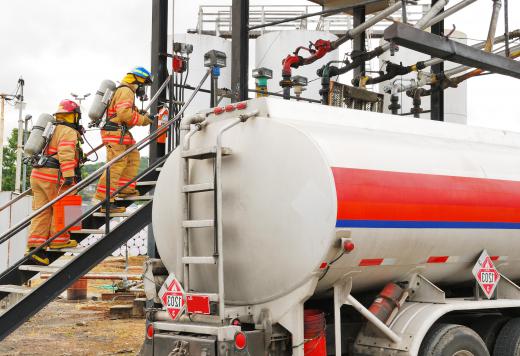A dry riser, known in some places as a standpipe, is an empty vertical water main within a multi-story structure. Some are connected at every floor to pipe networks that will distribute water to local sprinklers and firehose connections, and others simply have connections for firehoses. Dry risers have external connections at ground level accessible by firefighting personnel, who will make the connections to charge the systems with water. Usually installed inside fireproof stairwells, dry risers are required by all building codes in the US and most building codes worldwide for high-rise structures. In those jurisdictions where dry risers aren't required by local building codes, installation costs are often quickly recovered by savings in insurance premiums.
Water can be delivered by a dry riser to a fire site more quickly than firefighters hauling hoses up flights of stairs, especially in a high-rise structure. Most dry riser systems have lengths of fire hose already coupled to a connection on every floor, which saves valuable time in the event of an actual fire. When this is the case, some firefighters can use those hoses to start fighting a fire while their colleagues haul additional hoses to connect to the dry riser connections.

Many structures today have automatic sprinkler systems which are constantly maintained with a water supply under pressure. These systems are generally activated only when the temperature reaches a point above what's considered survivable by humans, when the ambient temperature causes a liquid in a fragile glass bulb to boil, breaking the glass. Automatic sprinklers are indispensable when it comes to saving property, but are not as effective in saving lives because they are stationary and cannot follow a fire or clear an escape path.
England was the site of the first installation of a dry riser, in 1812. It consisted of a large reservoir of water connected to a system of perforated pipes in a theater. When fire was discovered, a valve was opened and the system was charged with water that escaped from the perforations, extinguishing the fire. Dry risers quickly became popular in industrial applications like factories and warehouses in England and Europe, and spread quickly to the textile mills of New England.
Dry risers were initially employed as manually-activated sprinkler systems, but when they were supplanted by automatic systems, their main purpose was changed. In modern times, they are widely required in high-rise structures, even those that have automatic sprinkler systems in place, because they deliver a high volume of water under pressure directly to firefighting personnel. It is this ability to deliver water in great quantities to any specific point that enables firefighters to knock down fires quickly and save lives, a capability beyond automatic sprinkler systems.
